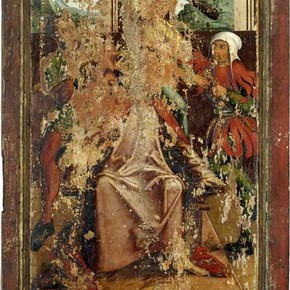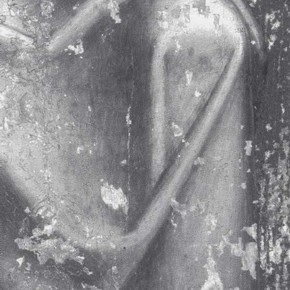Conservation Journal
Autumn 2002 Issue 42
From first aid to fluorite: Identification of a rare purple pigment
Introduction
The wooden polychrome panel, 260-1898, comprising the carved Nativity scene on the inside, and the panel painting Mocking of Christ on the outside, arrived in the Sculpture Conservation studio for first aid treatment. The polychromy of the panel painting was badly flaking and in urgent need of consolidation. The whole surface of the painting was also covered in a discoloured varnish and accumulated dirt, to the extent that the image was almost indistinguishable. The emergency treatment was followed by a decision to remove the discoloured varnish. As the varnish removal progressed it became apparent that, although severely damaged, the remaining polychromy of the panel painting was original with no overpaint. A thorough identification of the polychrome layer of the Nativity was undertaken, based on microscopic investigation of four cross sections and seventeen dispersed pigment samples. As a result of this analysis a rarely documented purple pigment, calcium fluoride, was found as one of the pigments used to render the colour of the Christ’s robe. The article discusses the properties and known usage of the purple fluorite. The conservation treatment is also described, with emphasis on the Mocking of Christ panel painting where the conservation was far more involved than on the carved Nativity scene.
Conservation treatment
The panel measuring 112 x 78 x 8 cm, would originally have formed one wing of a triptych. It dates to around 1500 and its provenance is Tyrol. The entire object is made of softwood. The polychrome carved panel on what originally would have been the inside of the wing depicts the Nativity scene. The badly damaged panel painting on the outside shows Mocking of Christ. Approximately one quarter of the polychromy on this panel is missing (Figure 1). The bottom right corner of the frame was loose and there was serious movement related to this damage. The pierced panel below the Nativity was also loose.
There is a record of a conservation treatment dating to 1955. The surviving documentation mentions the treatment of the Nativity only, which was at the time cleaned and consolidated. Overpaint was also removed from the architectural part of the carving. A detailed report on the recent conservation treatment and polychrome identification exists in the Sculpture Conservation files 1 .
This article summarises the most relevant parts of the treatment of the Mocking of Christ only. The severe flaking of the entire surface was first consolidated with isinglass, using the tissue and heated spatula method. This was the first overall consolidation which enabled safer handling of the panel painting without losing any more flakes. Prior to varnish and dirt removal the second consolidation was carried out, using Primal WS24, an acrylic dispersion, and a heated spatula. The varnish and dirt removal was then started. The best method proved to be softening the very discoloured varnish with a gel (200 ml of ethanol, 50 ml of toluene, 50 ml of water, 10 ml of Ethomeen C25 and 6g of Carbopol ETD 2623). The gel was removed with a mixture of 50% white spirit and 50% ethanol, occasionally a small amount of acetone was added to this mixture. Further consolidation was carried out at this time in areas which required it, using the same consolidant. Where necessary, additional cleaning was done with triammonium citrate (5% in water). This was mainly used to remove or reduce a grey veil found on several areas of deteriorated pigment. These areas are primarily the dark shadows where madder, a red lake, was used in the form of a glaze. Generally, as is common with these types of panel paintings, the more lead white is present in the paint, the better preserved it is. Therefore, the areas of lighter hue are in a better condition than the darker, sometimes more thinly painted, parts of the painting. After consolidation and cleaning the painting was varnished with dammar resin in Shellsol A.
Generally, the condition of the carved nativity was far better than that of the oil painting, probably due to the restoration carried out in 1955. The conservation methods were the same as on the other side of the panel but the extent of the treatment was far smaller. The consolidation of the loose corner of the frame was carried out with fish glue, a commercial product made in Canada. This also helped lock the pierced panel below the Nativity in its place. Two wooden pins were added to secure this panel further. The pins were put into the original holes, and the ends were retouched with acrylic paint. The numerous nail and screw holes in the frame were filled with pigmented beeswax.
Polychrome identification
The identification of the polychrome layer was concentrated mainly on the Mocking of Christ panel painting. The cross sections and dispersed pigment samples were examined under reflected and transmitted light, under UV light, and the dispersed pigment samples were further analysed using polarised light. The magnifications ranged from x90 to x400. Photomicrographs were taken of the cross sections only. No analysis of the medium was carried out, but it can be assumed that it is either oil tempera or drying oil on its own.
Based on the samples examined and on a thorough stereo microscopic survey of the surface it can be deduced that there is only one polychrome scheme present on the panel painting, and that it is original. No overpaint has been found. It appears that an old oil varnish had been removed from the surface in the past. Traces of it are visible in the cross sections under the more recent varnish, which has been removed during this conservation treatment. The use of gypsum rather than calcium carbonate for gesso is noted. The selective deterioration of the madder found in the dark red shadows is irreversible but enough pigment survives to give an indication of the artist’s intentions. The presence of madder was confirmed with ultraviolet light microscopy. It appears that the original decoration of the blue background to the Nativity may have been gilded and decorated with a strip of applique, but, unfortunately, not enough evidence has been found to ascertain this. The most interesting discovery proved to be the use of the purple pigment found in the Christ’s robe. (Figure 2)
Purple pigment
The purple pigment, clearly of mineral origin,was first noticed in a cross section taken from the Christ’s robe. It was found in a layer mixed with lead white, vermilion and black, over a layer of gesso. A dispersed pigment sample was made from this layer, and the purple pigment was identified under transmitted and polarised light as calcium fluoride. This is a fairly uncommon, or rather rarely documented, pigment found in the mountain regions of central Europe. Its sources were located in Bavaria, Tyrol, Silesia and Bohemia. The mining of the mineral fluorite was associated with mining of lead, zinc, silver, copper and iron ores. The colour of fluorite can range from colourless to yellow, green, rose, blue and purple. Together with its almost perfect cleavage these qualities made it a useful pigment. Historically it was employed as an artists’ pigment from about 1450 to 1520 in polychrome sculpture, panel and mural paintings, and in architectural polychromy. It was first identified as an artists’ pigment in 1968 and has since been found in works of art originating from Germany, Switzerland, Poland, Hungary and the Czech Republic 2 . As in the case of the Christ’s robe in the Mocking of Christ, where it was used in lead white together with vermilion and black, it is usually found in a mixture with other pigments to enhance a desired colour, as its tinting and hiding power is relatively low. In transmitted light some of the particles in our sample displayed typical purple, colourless and almost black banding, referred to as striations. It is hoped that further analysis of the fluorite pigment can be carried out by the Science Section at the V&A using Raman Spectroscopy, a non-destructive technique based on infrared laser 3 .
Conclusion
The first aid treatment of the panel led to a more involved conservation than originally intended, which in turn resulted in microscopic identification of the original materials. The identification of the purple fluorite pigment in the Christ’s robe in the Mocking of Christ panel painting represents a valuable addition to the relatively short list of European paintings where this pigment has been found. Another positive result of the recent conservation treatment is the fact that the panel has been moved into a more suitable storage space.
References
1. Alexandra Kosinova, conservation report, unpublished.
3. Lucia Burgio, Science Section of the V&A Conservation Department, proposed analysis.
Autumn 2002 Issue 42
- Editorial
- Travelling altar: Investigating an object
- From first aid to fluorite: Identification of a rare purple pigment
- Queen Elizabeth’s virginal scribbles, scratches and sgraffito
- Continued studies in the deterioration of glass
- Tethering the cow – Treatment and display of the Sackville Pedigree – a large 16th century heraldic parchment manuscript
- News from RCA/V&A Conservation
- Printer friendly version

